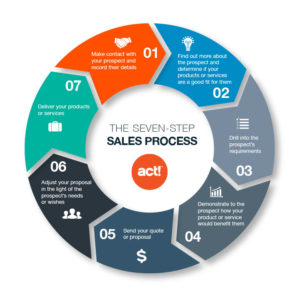
A sales process is a series of phases or steps which a prospect goes through, before becoming a customer. If you have been selling for a while now but don’t have an agreed-upon sales process, there is still one implicitly in place; it’s just not standardised and/or visible to you. A properly laid-out sales system provides your sales team with a concrete set of steps to follow whenever they approach a prospect and this helps them in closing more deals. Vantage Point Performance and the Sales Management Association conducted research that revealed that companies with formally documented sales processes observed 18% revenue growth compared to their counterparts with no such procedures. With that said, creating a standardised sales cycle with definite sales process steps can be tough because different team members can have different opinions and there can be plenty of diagrams and figures to consider and client behaviours to incorporate. In addition to this, a reusable sales process has to be reviewed periodically in order to maintain its relevance and effectiveness. Some of the factors that inhibit the building and sustenance of a sales cycle can be:
- Changing customer behaviour and needs.
- The emergence of new engagement channels. For example, if you add a new social media network to your set of engagement channels, then you will have to incorporate that into your sales process.
- New technologies that can be used to standardise and further optimise your sales cycle and the different sales process stages.
- The prevalence of new best practices and methodologies in the sales world.
Different sales processes can have different stages and no one-fits-all solution that can be applied to every company. Depending on your business model, client behaviours, and sales strategies, you have to come up with the perfect set of sales process stages for your company. Using sales software or a sales CRM for this purpose can be highly beneficial. An example sales process can consist of the following stages:
- Make contact: In the first step, you get in touch with your prospect and get a hold of their details.
- Know more: In the second step, you get to know more about the prospect and their requirements in the bid to figure out whether your products or services are a right fit for them.
- Requirement analysis.
- Prove your worth: In the fourth step, you explain to the prospect how (and why) exactly your products or services are the best fit for them.
- Present your quote or proposal.
- Incorporate their needs and/or wishes into the proposal.
- Offer your product or service.

Sales processes and sales methodologies often go hand in hand, but that doesn’t mean that they are the same thing. A sales methodology defines actionable steps for goals and objectives. For example, if your goal is to ask questions of the prospect and get valuable information; for that, you can use the SPIN selling methodology made by Neil Rackham which provides you with a tested system to ask questions. Unlike your sales process, a sales methodology isn’t normally applicable to all the parts of the sales cycle; instead, its relevance is restricted to specific stages like contacting, discovery or proposal, etc. Another difference between the two entities is that every company should come up with a unique, formalised sales process for itself which will not be relevant to any other company, but a sales methodology is something that can be adopted by any company or team, regardless of their vertical or business model. Some other examples of sales methodologies are: N.E.A.T. Selling, Conceptual Selling and SNAP selling etc.
Now that we have seen what a sales process is and how it differs from a sales methodology, let’s take a look at how any company can come up with its own standardised version:
1. Observe your sales representatives:
In order to create plans for the future, often the most prudent technique is to observe the past. Go back a few months, analyse the deals you closed and notice the most important steps that your salespeople followed. Calculate the average time it took to, for example, convince a prospect that your product is the answer or make them agree to your submitted proposal, etc. Find out the overall time it took to close the deal and find out the stages where most of the time was spent. After careful analysis, you should be able to figure out details like:
- On average, it takes two weeks before a prospect becomes a customer.
- It takes between 1 to 5 follow-up emails and calls before a customer finally agrees.
- A new prospect is found every other day.
- Most of the deals get stuck in the X stage.
- The smoothest sailing occurs in the Y stage.
These details can help you formalise your sales process.
2. Create a generic example by mapping observations:
No two prospects are similar so it’s difficult to agree on a generic sales process but most of the time, the observations can be mapped to create a generic example. For example, you can say that for Prospect A, two days are spent during contact, one day is spent for demo and so on.
3. What made the prospect move to the next stage? Make a note:
For every stage you define, you need to have a solid reason why and how a prospect moves from the previous stage to this one and from this one to the next. Questions like the following can help:
While calling different prospects, were there any specific notions which when raised, convinced people to schedule a demo?
When you submitted the proposal, did the customer immediately agree? If yes, then what were the exact steps that you followed before the proposal?
4. Periodically monitor and perpetually improve:
The market changes with every passing day and so do your customers’ expectations. Creating a standardised sales process is a never-ending job and hence, you have to monitor your sales cycle every now and again to ensure that it’s still relevant and still upholds the initially set-out standards of efficiency.
5. Benchmark your sales process:
It’s also a recommended practice to define metrics that can help you measure the success of your sales cycle. Examples can be the number of prospects that got converted into customers within a week in the last month, the number of prospects that stayed stuck in the proposal stage for over a week in the last two months, and the total number of prospects that got converted into customers in the previous month. These metrics will give you an idea of the areas that need improvement and the ones that have been performing at the highest levels.
Best practices and tips for success:
- Don’t stick with one sales methodology; have an open mind: It’s always beneficial for a company to take help from wherever it sees fit. If you think that adopting a small part of methodology X and using it in tandem with methodology Y will do the job for you, then do that.
- Know that there is always room for improvement: Your sales process should improve over time and incorporate the changes in customer needs and the technological world.
- Make use of modern software: By using state-of-the-art sales software and sales CRM (Act! is a great shout), you can automate most of the mundane tasks and maintain a more holistic view of your sales cycle at all times.
Final word:
A sales process is always going to be a work in process but if you follow some of the steps and tips mentioned above, you can have a substantial competitive advantage over your counterparts. Choosing the right sales methodology can often require a vivid analysis of the customer needs and your business model, but it can help a lot in fine-tuning your sales cycle. Using sophisticated sales software or a sales CRM can also go a long way in your bid to build a standardised sales process.





